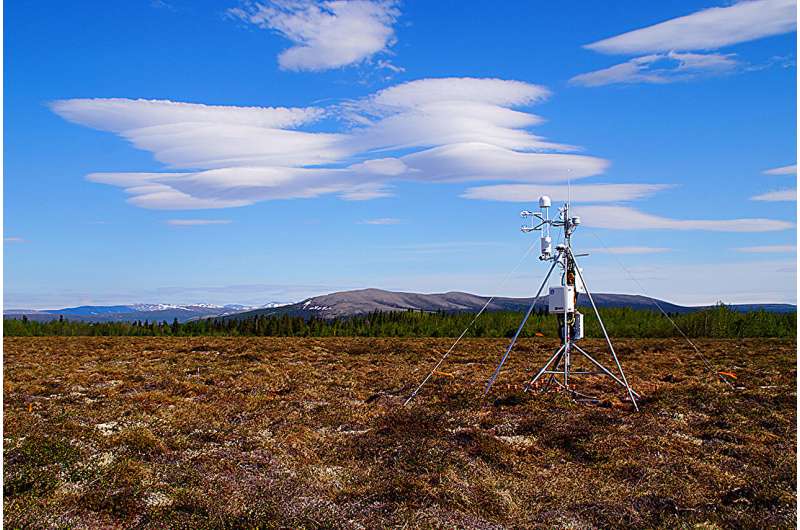Increase in Methane Emissions from Wetlands Surges in High Latitudes, Study Finds

February 15, 2024
The article underwent a thorough review under Science X's editorial guidelines and policies to ensure credibility. The examination process included aspects such as:
- fact-checking
- analysis by peer-reviewed publication
- verification by a trusted source
- proofreading
The revision process was administered by Julie Bobyock, from the Lawrence Berkeley National Laboratory.
The world's largest natural source of methane, a powerful greenhouse gas far more potent than carbon dioxide, is wetlands. According to a research team from the Department of Energy's Lawrence Berkeley National Laboratory, a comprehensive analysis of wetland methane emissions in the entire Boreal-Arctic region shows a 9% increase since 2002.
Studying livestock and fossil fuel production for their substantial methane release is common. Despite being more complex, it remains essential to quantify methane emissions from natural wetlands to better project climate change developments.
It is expected that methane emissions from wetlands are increasing due to Boreal and Arctic ecosystems experiencing temperatures rising at quadruple the average global rate. Yet, the ability to gauge the rise has remained elusive due to the challenge of monitoring emissions in these expansive and frequently water-saturated environments—until recently.
Qing Zhu, a Lawrence Berkeley National Laboratory scientist and senior author, alongside Lawrence Lab postdoctoral researcher Kunxiaojia Yuan, describe the Boreal and Arctic ecosystems as being carbon-rich and susceptible to warming. Their recent study analyzed data from sophisticated monitoring methods which showed methane emissions increased by 9% over the last two decades.
The researchers' approach is detailed in a paper published this week in Nature Climate Change.
Zhu points out that rising temperatures correlate with increased microbial activity and plant growth, leading to a higher release of gases like methane. By understanding how natural methane sources shift, scientists can monitor greenhouse gases more accurately, providing insights into the current and future state of climate change.
The molecular structure of methane allows it to warm the atmosphere 30 times more effectively than CO2, despite its atmospheric life being significantly shorter—10 years compared to carbon dioxide's 300.
Increased temperatures not only accelerate the metabolic activity of methane-releasing microbes residing in waterlogged soils but also expand these saturated regions as permafrost melt and more precipitation occurs as rain instead of snow. The expectation of increasing methane emissions in these cold, high-altitude areas and the importance of accurately quantifying methane output becomes clearer with these observations.
Traditionally, greenhouse gas release is measured by collecting gases emitted by soils at a precise location in a chamber over a set period. A more independent approach involves using tall eddy covariance towers that continuously measure greenhouse gas exchanges between soils, plants, and the atmosphere across large ecosystem areas, including difficult to access areas like wetlands.
The research team from Berkeley Lab combined data from both methods to analyze methane emissions from wetland sites in the Arctic-Boreal region over 307 years. This approach facilitated a better understanding of the factors driving emissions over hundreds of acres of land and varying timescales.
The team discovered that these regions have released an average of 20 teragrams of methane annually from 2002 to 2021. This amount is equivalent to the weight of approximately 55 Empire State buildings, with a 9% increase in emissions noted since 2002.
In-depth examination of two 'hotspot' areas in the Arctic and Boreal regions, where methane emissions are notably greater than surrounding areas, revealed about half the average methane emissions originated from these hotspots. This information proves crucial for directing future mitigation efforts and measurements.
Environmental factors driving increased methane emissions were also investigated by the researchers. They identified two primary causes: temperature and plant productivity.
Rising temperatures amplify microbial activity, leading to higher methane release. The study discovered that temperature had the most dominant influence on wetland emissions and its variability in the Boreal-Arctic regions.
This can lead to climate feedback, where methane emissions from increased microbial activity increase atmospheric temperatures, leading back to more methane emissions, and so on.
Higher plant productivity increases the amount of carbon in the soil, which fuels methane-producing microbes. The researchers found that when plants were more productive and active, releasing substrates that help microbes to thrive, wetland methane emissions increased.
The team also identified that the year with the highest wetland methane emissions, 2016, was also the warmest year in the high latitudes since 1950.
Because methane has a fairly short lifetime in the atmosphere, it can be reduced and removed relatively quickly,' Zhu explains. 'By providing a more accurate understanding of the role wetlands play in the global climate system and how and at what pace their methane emissions have increased, this research can offer a scientific baseline to help understand and address climate change.'
Journal information: Nature Climate Change
Provided by Lawrence Berkeley National Laboratory




